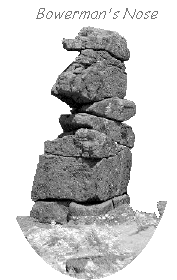Dartmoor differs from other National Parks in England and Wales in the provisions for access to its land. Since an Act of Parliament of 1985, much of it has been designated as 'Access Land' with no restrictions on where walkers and horse-riders can roam.
The footpaths in these areas of the park are for guidance and convenience but do not have to be adhered to and are generally not waymarked.
|
The Access Land is edged in purple for easy reference on larger scale Ordnance Survey maps of Dartmoor (1:25,000).
|
Other parts of the Park are accessed via the usual network of footpaths and bridleways - park contains 966 km (600 miles) of public rights of way.
These access arrangements in the Park are not connected with the Labour government's Countryside and Rights of Way Act 2000, which in due course will establish similar rights in other rural parts of the country. Because of the existing arrangements, Dartmoor will be largely unaffected by this new legislation.
Tales of the Dartmoor Pixies: Glimpses of Elfin Haunts and Antics
by William Crossing, 1890
Walking on Dartmoor: National Park and Surrounding Areas
The "Cicerone Guides" series
by John Earle, 2002
Dartmoor 365: An Exploration of Every One of the 365 Square Miles in the Dartmoor National Park
by John Hayward, 1991
Dartmoor and Exmoor National Parks, Maps and Gazetteer
Walks in the Dartmoor National Park
Walks in the Dartmoor National Park: The Dart Valley
The Dartmoor and Exmoor National Parks: Changes in Farming Structure, 1952-1972
Dartmoor National Park Plan
The Dartmoor National Park (Restriction of Agricultural Operations) Order 1991: Countryside (Statutory Instruments: 1991: 1616)
National Park Guide: Dartmoor
The "Pevensey National Park 50th Anniversary Guides" series
Dartmoor Seasons
by Elizabeth Prince
Great Walks: Dartmoor and Exmoor
The "Great Walks Series" series
by John Weir and Brian Lemessurier
Walks and rides on Dartmoor
by HD Westacott
Dartmoor and Exmoor
The "Great Walks" series
by John Weir, et. al.
Dartmoor : a report by Lady Sharp G.B.E. to the Secretary of State for the Environment and the Secretary of State for Defence of a Public Local Inquiry Held in December 1975 and May 1976 into the continued use of Dartmoor by the Ministry of Defence for Training Purposes
by Evelyn Adelaide Sharp
The Environment: Principles and Applications
by Chris C. Park
Crossing s Guide to Dartmoor
by William Crossing
The Dartmoor Worker
by William Crossing
Dartmoor s Early Historic and Medieval Remains
by William Crossing
Leaves from Sherwood, etc.
by William Crossing, publisher Plymouth, 1868
The Ancient Crosses of Dartmoor; with a Description of their Surroundings
by William Crossing, publisher Exeter, 1887
Amid Devonia s Alps, or, Wanderings and Adventures on Dartmoor
by William Crossing, publisher Plymouth, 1888
Crockern Tor and the Ancient Stannary Parliament
by William crossing, publisher Exeter, 1892
The Hound of the Baskervilles
The "Sherlock Holmes" series
by Sir Arthur Conan Doyle, 1901
Recommend a Book for this Page







